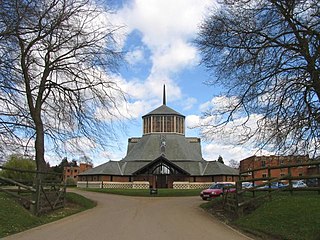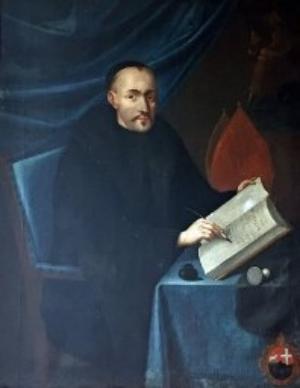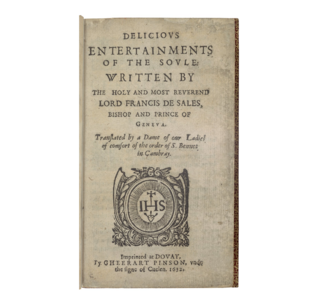Related Research Articles

The Benedictines, officially the Order of Saint Benedict, are a mainly contemplative monastic order of the Catholic Church for men and for women who follow the Rule of Saint Benedict. Initiated in 529, they are the oldest of all the religious orders in the Latin Church. The male religious are also sometimes called the Black Monks, especially in English speaking countries, after the colour of their habits, although some, like the Olivetans, wear white. They were founded by Benedict of Nursia, a 6th-century Italian monk who laid the foundations of Benedictine monasticism through the formulation of his Rule. Benedict's sister, Scholastica, possibly his twin, also became a religious from an early age, but chose to live as a hermit. They retained a close relationship until her death.

St Benet's Hall was a permanent private hall (PPH) of the University of Oxford, originally a Roman Catholic religious house of studies. It closed in 2022. The principal building was located at the northern end of St Giles' on its western side, close to the junction with Woodstock Road, Oxford.

The Bridgettines, or Birgittines, formally known as the Order of the Most Holy Saviour, is a monastic religious order of the Catholic Church founded by Saint Birgitta in 1344 and approved by Pope Urban V in 1370. They follow the Rule of Saint Augustine. There are today several different branches of Bridgettines.

Mary Magdalene de' Pazzi, OCarm, was an Italian Carmelite nun and mystic. She has been declared a saint by the Catholic Church.

Augustine Baker OSB, also sometimes known as "Austin Baker", was a well-known Benedictine mystic and an ascetic writer. He was one of the earliest members of the English Benedictine Congregation which was newly restored to England after the Reformation.

The English Benedictine Congregation (EBC) is a congregation of autonomous abbatial and prioral monastic communities of Catholic Benedictine monks, nuns, and lay oblates. It is technically the oldest of the nineteen congregations affiliated to the Benedictine Confederation.

The University of Douai was a former university in Douai, France. With a medieval heritage of scholarly activities in Douai, the university was established in 1559 and lectures started in 1562. It closed from 1795 to 1808. In 1887, it was transferred as University of Lille 27 km away from Douai.
St Mary's Abbey, also known as Malling Abbey, is an abbey of Anglican Benedictine nuns located in West Malling, Kent, England. It was founded around 1090 by Gundulf, Bishop of Rochester and dissolved in 1538. The site became a monastery again in the late 19th century.

Douai Abbey is a Benedictine Abbey at Upper Woolhampton, near Thatcham, in the English county of Berkshire, situated within the Roman Catholic Diocese of Portsmouth. Monks from the monastery of St. Edmund's, in Douai, France, came to Woolhampton in 1903 when the community left France as a result of anti-clerical legislation. The abbey church is listed Grade II* on the National Heritage List for England.

Stanbrook Abbey is a Catholic contemplative Benedictine Monastery with the status of an abbey, located at Wass, North Yorkshire, England.

Alban Roe was an English Benedictine priest, remembered as one of the Forty Martyrs of England and Wales.

Lamspringe Abbey is a former religious house of the English Benedictines in exile, at Lamspringe near Hildesheim in Germany.

Douai School was a public school run by the Douai Abbey Benedictine community at Woolhampton, England, until it closed in 1999.

Ampleforth Abbey is a monastery of Benedictine monks a mile to the east of Ampleforth, North Yorkshire, England, part of the English Benedictine Congregation. It descends from the pre-Reformation community at Westminster Abbey through the last surviving monk from Westminster, Sigebert Buckley. As of 2024 the monastery has 41 monks, and sometimes will have 50 nuns of the monastery organization.
Gabriel Gifford, OSB was an English Benedictine monk who became Archbishop of Reims.

St Cecilia's Abbey, Ryde is an abbey of Benedictine nuns in the Isle of Wight, England.

Clement Reyner D.D. (1589–1651) was an English Benedictine monk, who became abbot of Lamspringe in Germany.
Mary Percy (1570–1642) was an English noblewoman who founded an English Benedictine Monastery in Brussels and served as its abbess.

Catherine Gascoigne was the English abbess of Cambrai from 1624 to 1673.

Pudentiana Deacon was a Benedictine nun now known for her translation of Les vrais entretiens spirituels by Francis de Sales (1557–1662).
References
- 1 2 3 Bellenger, Dominic Aidan. "Brown, George [name in religion Gregory]". Oxford Dictionary of National Biography (online ed.). Oxford University Press. doi:10.1093/ref:odnb/3605.(Subscription or UK public library membership required.)
- ↑ Beattie, Gordon (1997). Gregory's Angels. Gracewing Publishing. p. 75. ISBN 9780852443866.
- ↑ Arblaster, Paul. "The Sixty Years of Foundation, 1615-1676" (PDF). Douai Abbey. p. 3. Retrieved 5 October 2019.
- ↑ Cooper, Thompson (1886). . In Stephen, Leslie (ed.). Dictionary of National Biography . Vol. 7. London: Smith, Elder & Co.